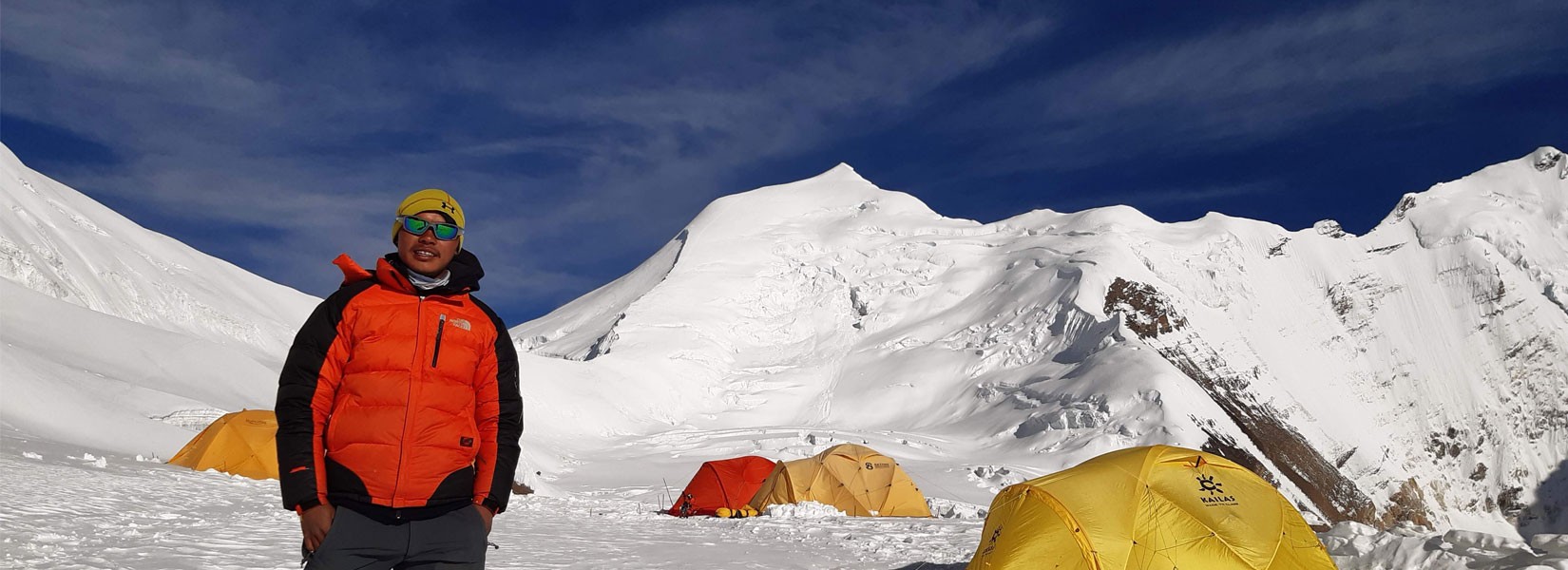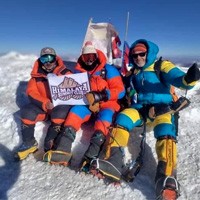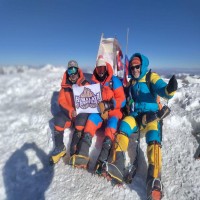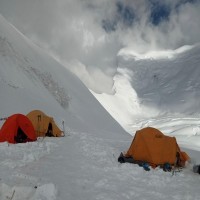-
Destination: Nepal
-
Trip Style: Expedition
-
Transport: As Per Itinerary
-
Food: As Per Itinerary
-
Accommodation: Lodge + Camping
-
Group Size: 1-15
-
Max Elevation: 7126m/23,375ft
Introduction:
Himlung Himal (7,126m) lies in the Peri Damodar range of the Annapurna region. The peak is located towards the northwest of Nepal, close to the Tibet border. The Peri-Damodar range is known for its spectacular peaks and challenging climbs. In addition to Himlung Himal, other notable peaks in the range include Chulu East, Chulu West, and Damodar Himal. Being in such close distance to Tibet, the Himlung region offers an immersive experience of the Tibetan culture, language, architecture, and history.
The region is relatively remote and requires a long trek to reach the base camp of this peak. Himlung Himal was first climbed in 1992 by a Japanese team, and since then, it has been climbed by several expeditions. The caravan route runs through high passes, remote villages, narrow gullies, forests, sheer rock cliffs, springs, Gompas, and unique cultural settlements. Since the area is remote and untouched, it sees very few visitors.
Himlung Himal is popular among climbers who want to scale new heights in mountaineering. Being 7000er, the mountain does not have technical difficulties as other technical peaks do and is often popularized as a preparatory climb for a first 8000er. Nonetheless, Himlung Himal is one of the most attainable and exciting Himalayan 7000ers ever to exist.
Himalaya Summit Club is dedicated to the safety and security in the high mountains. The safety and security of our climbing members is a topmost priority. Our experience in mountaineering and strategic planning has made our expeditions and adventures successful.
"Experience Himlung Himal with Himalaya Summit Club"
Useful Information
Why Himalaya Summit Club?
The HSC team is composed of dedicated mountain guides and alpine professionals who have years of experience in mountaineering and high altitude trainings. The executive team members are internationally recognized and certified by various esteemed programs and organizations including the IFMGA/UIAGM.
International Standard Service
At Himalaya Summit Club, we provide services of the highest caliber. Our services are designed to meet your needs and exceed your expectations.
Safety and Security
The safety and security of our clients is our main priority at Himalaya Summit Club. Our team members are trained in client safety and security, which is essential during high-altitude mountaineering. Our trips are designed to provide enough rest and acclimatization for our clients, ultimately leading to success in their goals.
Logistics and Planning
At Himalaya Summit Club, we are committed to appropriate planning. We are aware of the existing challenges in the high mountains and remain ever-ready to address them. Our logistics and supplies meet international standards, ensuring comfort and safety in the mountains.
Association with National and International Tourism Associations
We are affiliated with various national and international associations. Nationally, our mountain guides and executive members are associated with the Nepal Mountaineering Instructors Association (NMIA) and the Nepal National Mountain Guides Association (NNMGA). Apart from the internationally certified members, the club itself has ties with a number of international associations.
Equipment List
Climbing-
- Mountaineering Harness
- 3 meters 8mm Rope and 4 Meters 6-7mm Climbers accessory cord
- Belay Device (anyone: figure of 8, ATC, ATC Guide)
- Ascender (JUMAR)
- 3 locking Carabiners
- 2 Regular Carabiners
- Mountaineering Ice Axe
- Crampons-must fit boots perfectly; steel crampons with anti balling plates are the good.
- Optional: adjustable trekking poles.
Upper Body-
- 2 Cotton T-shirts
- 1 polypropylene T-shirt
- 2 long sleeve polypropylene Shirts, lightweight
- 1 polar fleece pullovers, medium weight
- 1 polar fleece jacket
- Gore-Tex jacke with hood, waterproof and breathable
- 1 very warm goose-Down (duvet) jacket with hood
- Umbrella (optional)
Hands-
- 1 lightweight poly-liner gloves. These will be worn when tying knots, but not inside your mitts
- 1 pair mittens, consists of 1 Gore-tex over mitt matched with the very warm polar fleece mitt liner (For more about high altitude mitts
Head-
- Helmet;
- Warm hat wool or synthetic that covers your ears;
- Balaclava;
- Face mask;
- Ballcap or brimmed sun cap;
- Glacier sunglass with side shields (you can purchase these inexpensively in Kathmandu, including prescription sunglasses
- 1 pair ski goggles (Optional) with light and dark lens;
- Headlamp with extra batteries and bulbs;
- Bandana or head scarf, also useful for dusty conditions
Lower Body-
- Cotton underwear briefs;1 pair walking shorts;
- 1 pair walking trousers for trekking and around camp;
- 2 pair lightweight thermal bottoms;
- 1 pair medium or expedition weight thermal bottoms;
- 1 pair polar fleece trousers;
- 1 pair Gore-Tex trousers, salopettes, or bibs. Waterproof/breathable with full side zips;
- 1 Goose-down (duvet) trousers
- Your clothing should be kept dry using waterproof stuff sacks, bin-liners, or large plastic bags. Feet-
- 1 pair double plastic boots (koflach style) or 1 pair One-Sport Millet Everest boots or equivalent,
- 1 pair sturdy leather walking boots with good ankle support (we mean leather trekking, not climbing boots) for the walk to advanced base camp;
- 1 pair trainers, running shoes and/or sandals for Kathmandu and in camp
- 1 pair down booties (optional);
- 2 pair med-heavy poly or wool socks;
- 2 pair of liner socks. Polypropylene or wool
- 2 pair lightweight trekking socks, poly or wool;
- Cotton socks for in town.
Sleeping-
- 1 high altitude, down (duvet) sleeping bag (rated to – 30 Centigrade or -0 Fahrenheit). In the high camp, you can sleep in your down clothing inside the tent;
- At least 3 closed cell foam kari-mats for use in base camp and high altitude, We do not recommend inflatable mats, as we have never seen one not puncture. You can buy these non inflatable mats very inexpensively in Kathmandu. Why carry foam mats around the world, when you can purchase them inexpensively in Kathmandu?
Your sleeping bag should be kept dry using waterproof stuff sacks, bin-liners, or large plastic bags.
Rucksack and Travel Bags-
- 1 medium rucksack (50-70 litres / 3000-4500 cubic inches, can be used for airplane carry);
- Waterproof rucksack cover (optional);
- 1 large (120 L / 7500 cubic inch) duffle kit bags for clothing and equipment. Must be durable for use on pack animals;
Personal Hygiene-
- female or male hygiene supplies;
- 2 tubes lip sun cream, 1 large tube skin sun cream (min. factor 15);
- anti-mosquito cream;
- 1 toothpaste/brush;
- 1 bar soap or hand sanitizer gel/1 small towel;
- hand wipes.
Medical-
Medications are inexpensive and readily available in Kathmandu with no Doctor`s prescription:
- Small personal first-aid kit. (Simple and Light), blister repair kit, waterproof first-aid tape, athletic tape, plasters, Band-Aids, personal medications, etc. The leaders will have extensive first-aid kits, so leave anything extra behind. Please let your leader know about any medical issues before the climb;
- 10 anti-diarrhea pills (Imodium, Loperamide);
- 10 anti-headache pills (Paracetamol, Tylenol);
- 10 anti-inflammatory pills (Ibuprofen);
- 20 cough lozenges, cough sweets, Strepsils, Halls;
- 1 small bottle anti-altitude sickness pills: Diamox, Acetyzolamide;
- 10 stomach antibiotic pills: (Ciprofloxacin, Norfloxacin);
- 6 broad spectrum antiobiotic pills: (Azithromycin);
- Do not bring sleeping pills. They are a respiratory depressant
- 1 Steripen, or bottle of water purification tablets or water filter
- 1 set earplugs;
- 1 small bottle of hand-sanitizer
- Sun cream for skin and lips. minimum factor 20
Extra prescription of Glasses: contact lens supplies. Contact lens wearers, WARNING: your contact lenses might not work well on the mountain, please carry glasses at all times in case of emergency. A new pair could be quickly made in Kathmandu around $45. Please order prior to arrival if you are interested. A new pair could be quickly made in Kathmandu.
Personal Food-
Our skillful cooks prepare 3 delicious hot meals and plenty of drinks each day along the trek and in base camp.
On the mountain we supply plenty of food for you to cook 3 hot meals each day. This food will consist of soup, local cheese & sausage, biscuits, dried noodles, potatoes, rice, porridge, butter, dried and tinned vegetables, fruit, meats, and fish, tea with milk and sugar, powdered juice drink, and drinking chocolate. Our staffs will be carrying this food to the higher camps.
- We ask each client to bring their own imported daily snack and energy foods. We also ask clients to bring 3 dehydrated meals (freeze-dried dinners) for their summit attempt. We do not provide cold “snack” food such as chocolate or "energy-bars". We ask that you bring or buy your own "snack" or daily cold energy food, 2-5 kilos/4-10 pounds, is a good amount. A growing variety of imported foods such as European and American cheeses, chocolates, biscuits, cookies, nuts, and locally made power-bars are now available in Kathmandu, at realistic prices. However, imported power bars, GU, re-hydration drinks, dehydrated food, "freeze-dried meals", imported cheese and sausage are not available. If you want these items, you must bring them from your home country. Many of our Clients, especially Britons, Europeans, and Australians with tiny baggage allowances, now purchase their daily snacks in Kathmandu. Our schedule in Kathmandu allows plenty of time for shopping.
Practical Item
- 1 small roll of repair tape, 1 sewing repair kit;
- 1 cigarette lighter, 1 small box matches;
- 1 compass or GPS;
- 1 battery powered alarm clock/watch;
- 1 camera and film, or digital camera with extra cards and extra batteries;
- nylon stuff sacks For food and gear storage, large Ziplocs are useful also;
- 3 water bottles (1 litre) wide-mouth Nalgene (1 is a pee bottle);
- 1 plastic cup and spoon;
- 1 small folding knife;
- binoculars (optional);
- 4 large, waterproof, disposable rubbish sacks;
- passport, 2 extra passport photos, flight ticket, flight itinerary;
- Separate Photocopies of passport and relevant visa pages, proof of insurance;
- Dollors, Pounds or Euros, Cash for purchasing Nepalese visa at Kathmandu airport, Tibet visa, for paying for restaurants and hotels, for gratuities, snacks, and to purchase your own drinks and gifts;
- Credit Cards, Bank/ATM/Cash Machine Cards for use for withdrawing funds from cash machines (bring a photocopy of your cards), traveler's checks, etc.;
- 1 bathing suit/swimming costume (you never know);
- Base camp entertainment. It is good to bring additional items which you have found to be useful on previous expeditions. For example: paperback books, playing cards, I pod mp3 player, short-wave radio, game boys, musical instruments, ear plugs, lots of batteries, etc.;
- travel clothes for base camp and in town;
Please be sure and bring your patience and try to keep an open, relaxed, positive and friendly attitude as travelling in this part of the world may be very different than what you are used to, but things always seem to fall into place at the last moment.



